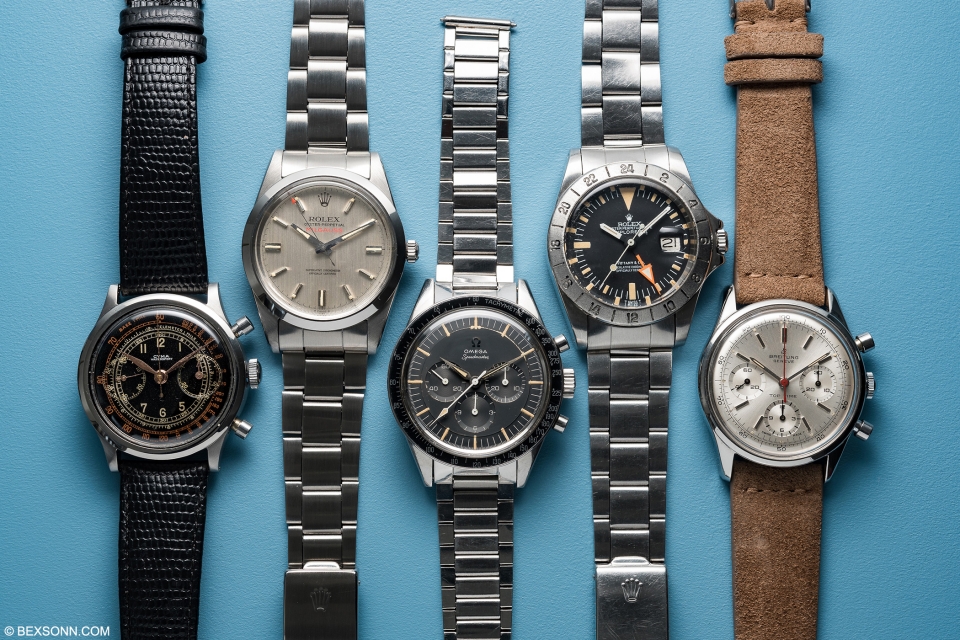Yep, it is September folks and of course that means the Watches of Knightsbridge auction is upon us. Flicking through the lots of this month’s auction, I couldn’t help noticing something that isn’t perhaps as apparent to many but something that stuck out to me. There are 333 lots, for those of you who may be unaware this number has a spiritual meaning but I won’t go into the minutiae of this but let’s just say, we are dubbing this the Watches of Knightsbridge Angel Auction. In typical fashion, we dropped by their offices to view a few of the upcoming lots and of course we’ve taken it upon ourselves to highlight a few lots we think are worthy of mentioning.
BREITLING TOP TIME 810
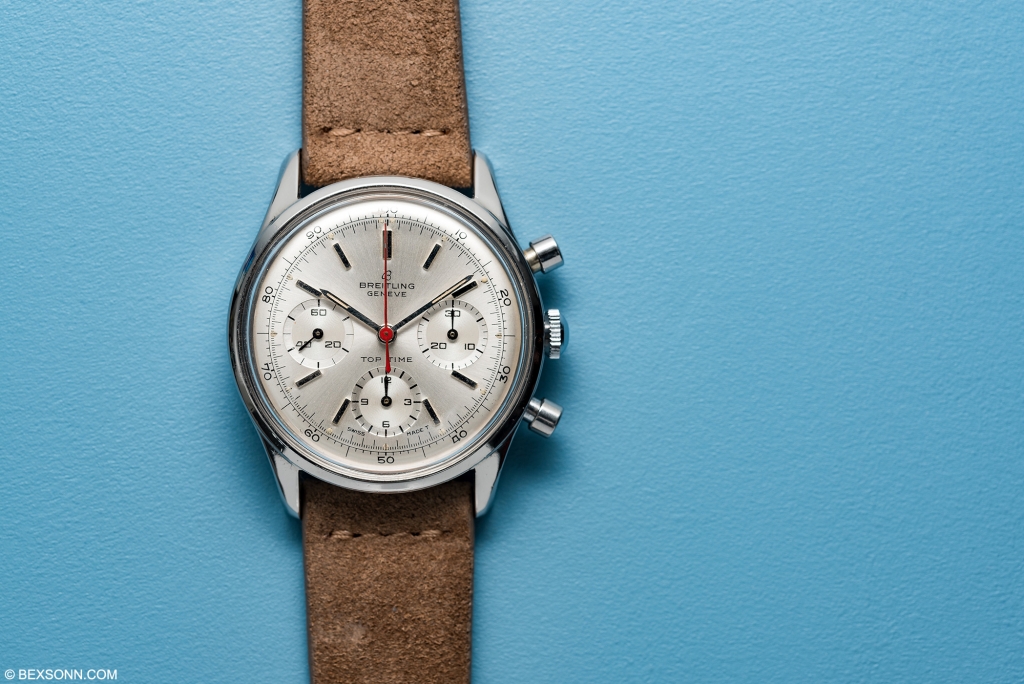 Lot 43: There seems to be a bit of a buzz around vintage Breitling at the moment and the brand is now under new ownership, with Georges Kern at the helm, perhaps bodes well for the future. Previously, vintage Breitling’s were largely ignored by collectors for some reason, however, I believe the Breitling Top Time 810 not only offers great value for money but it’s simple, clean, and sporty design is a great combination. This Mk1.1 with ‘monocoque’ case is just perfect and the way the lugs greet the 38.5mm case, adds to the overall effect and charm. Note the Mk1.1 lugs do differ in design and size does differ ever-so slightly from the other cases. It sports a silver sunburst, albino dial, with a decimal scale on the outer dial flange, baton markers and period correct baton hands. Beating away inside this Top Time is Breitling’s preferred chronograph movement, a true workhorse: the Venus 178, that of course was used in the Navitimers and Cosmonautes. This particular example is up for auction at an estimated £3,500 – £4,500, which is in-keeping with today’s market prices but also indicates vintage Breitling’s are still on the rise.
Lot 43: There seems to be a bit of a buzz around vintage Breitling at the moment and the brand is now under new ownership, with Georges Kern at the helm, perhaps bodes well for the future. Previously, vintage Breitling’s were largely ignored by collectors for some reason, however, I believe the Breitling Top Time 810 not only offers great value for money but it’s simple, clean, and sporty design is a great combination. This Mk1.1 with ‘monocoque’ case is just perfect and the way the lugs greet the 38.5mm case, adds to the overall effect and charm. Note the Mk1.1 lugs do differ in design and size does differ ever-so slightly from the other cases. It sports a silver sunburst, albino dial, with a decimal scale on the outer dial flange, baton markers and period correct baton hands. Beating away inside this Top Time is Breitling’s preferred chronograph movement, a true workhorse: the Venus 178, that of course was used in the Navitimers and Cosmonautes. This particular example is up for auction at an estimated £3,500 – £4,500, which is in-keeping with today’s market prices but also indicates vintage Breitling’s are still on the rise.
YEMA YACHTINGRAF CROISIÈRE
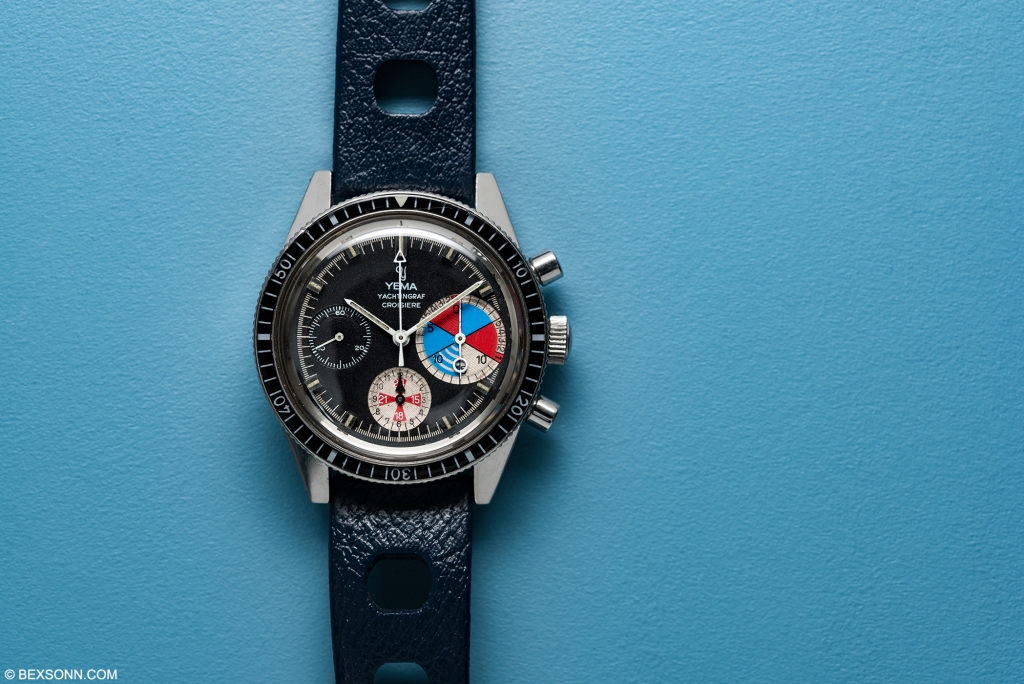 Lot 89: Yema have seen a dramatic rise in popularity in collecting circles and this Yachtingraf is a special piece. Yema watches bear striking similarities to watches made by Heuer and this just may be one of the reasons for its increased admiration. Founded in 1948, Yema are known for making some beautiful chronographs in the 60s and 70s and of those pieces the Yachtingraf is possibly one of the most colourful. The Yema Yachtingraf Croisière (Cruise in French) just happens to be the only Yachtingraf to feature three sub dials and I say only this because there are a few variations of these Regatta-style Yema’s.
Lot 89: Yema have seen a dramatic rise in popularity in collecting circles and this Yachtingraf is a special piece. Yema watches bear striking similarities to watches made by Heuer and this just may be one of the reasons for its increased admiration. Founded in 1948, Yema are known for making some beautiful chronographs in the 60s and 70s and of those pieces the Yachtingraf is possibly one of the most colourful. The Yema Yachtingraf Croisière (Cruise in French) just happens to be the only Yachtingraf to feature three sub dials and I say only this because there are a few variations of these Regatta-style Yema’s.
This example is in excellent condition, with a well-preserved black matte dial as most tend to become quite scruffy, with the white sections of the sub dials almost turning a mouldy green. The blue and red regatta countdown sub dial is as vibrant as one could ask. The case is in exceptional, sharp, condition, with its bakelite bezel still intact and comes on a rather fetching blue rubber tropic strap. And what’s more, this 1968 Yema Yachtingraf also comes with the original inner and outer box, something seldom seen. It is up for auction at an estimate of £3,500 – £4,500.
CYMA CLAMSHELL CHRONOGRAPH
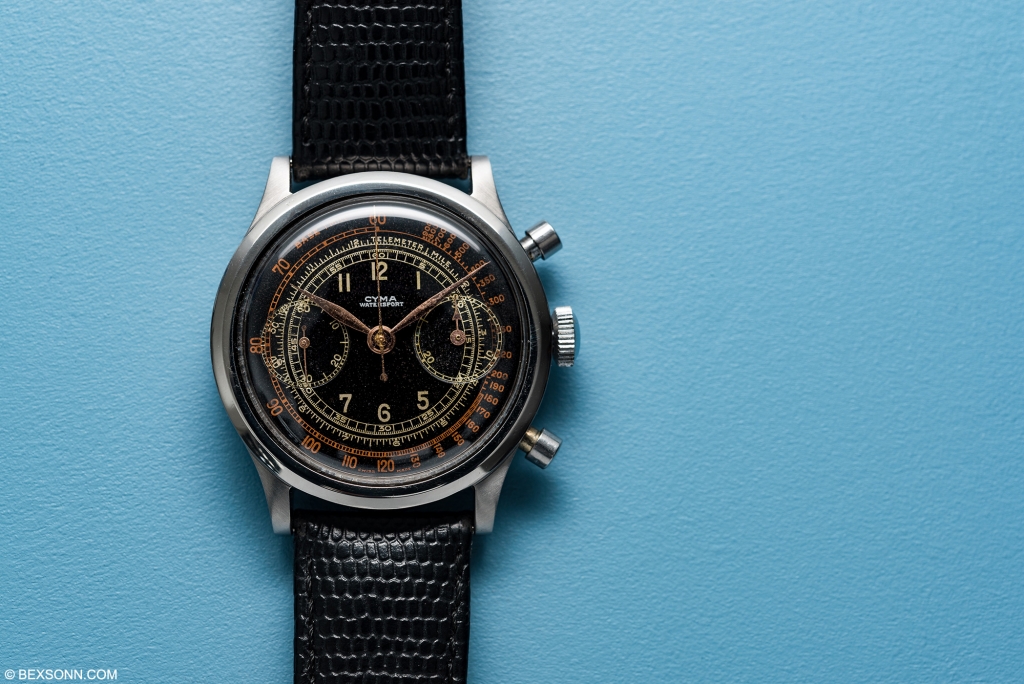 Lot 106: There is a recurring trend as to what the most popular chronographs are today. Multi scale glossy black gilt dial, check. Large 38mm stainless steel clamshell case with round pump pushers, check. All this, and more. Looking at the glossy gilt dial of this CYMA chrono, it is evident to see it has been rather well-preserved. While it is relatively easy to find black gilt dial chronographs in the vintage market, this particular one has so much more going for it. A closer inspection shows a vibrant orange outer tachymeter track that gives a great contrast to the watch. Adding further depth to this clamshell CYMA chronograph is the gilt inner telemeter scale, with the addition of gilt Arabic numerals too. Topping it off, this Cyma is powered by a 17-jewel 946 calibre column-wheel chronograph, signed by CYMA. Overall, the condition, quality and rarity of this watch makes it one of my favourite pieces in the auction and while the estimate may appear to be quite high, the question you have to ask is when are you going to find another, let alone in this condition? This Clamshell CYMA chronograph is up for auction at an estimate of £5,000 – £7,000 but I wouldn’t be surprised if it went for more.
Lot 106: There is a recurring trend as to what the most popular chronographs are today. Multi scale glossy black gilt dial, check. Large 38mm stainless steel clamshell case with round pump pushers, check. All this, and more. Looking at the glossy gilt dial of this CYMA chrono, it is evident to see it has been rather well-preserved. While it is relatively easy to find black gilt dial chronographs in the vintage market, this particular one has so much more going for it. A closer inspection shows a vibrant orange outer tachymeter track that gives a great contrast to the watch. Adding further depth to this clamshell CYMA chronograph is the gilt inner telemeter scale, with the addition of gilt Arabic numerals too. Topping it off, this Cyma is powered by a 17-jewel 946 calibre column-wheel chronograph, signed by CYMA. Overall, the condition, quality and rarity of this watch makes it one of my favourite pieces in the auction and while the estimate may appear to be quite high, the question you have to ask is when are you going to find another, let alone in this condition? This Clamshell CYMA chronograph is up for auction at an estimate of £5,000 – £7,000 but I wouldn’t be surprised if it went for more.
LEMANIA BRITISH MILITARY MONO-PUSHER CHRONOGRAPH
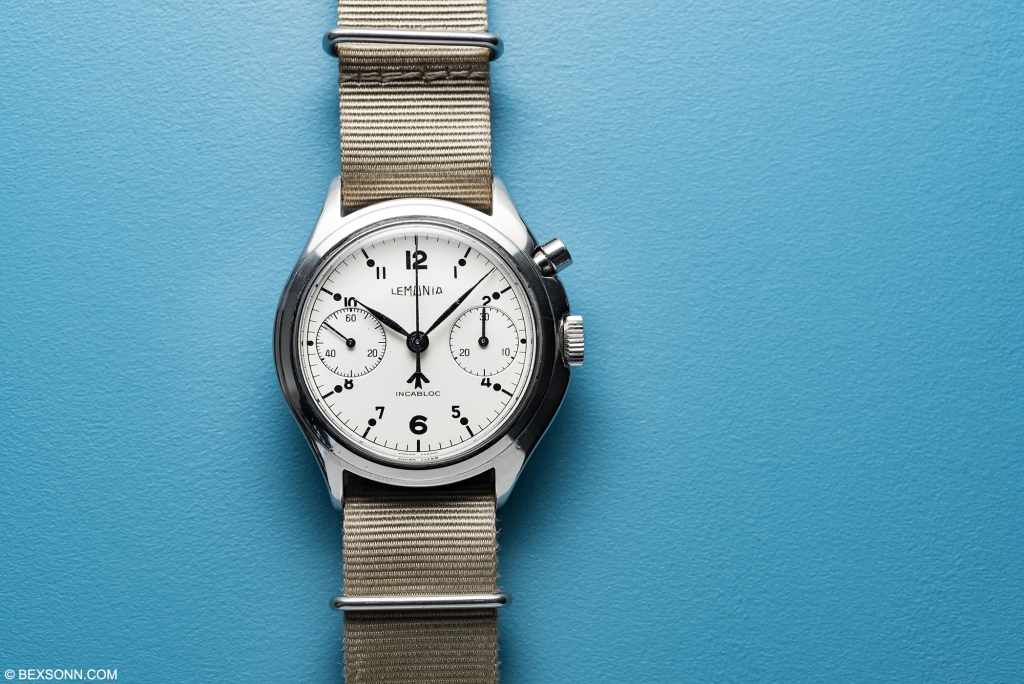 Lot 137: Very rarely do we highlight military Lemania’s but this particular 4th generation Lemania Military Chronograph above was only issued to the British Royal Navy. First introduced in the 1960’s, it was initially designed to be worn by Aircrew in the RAF, mostly navigators, and was produced from around 1965 – 1976 and in my humble opinion, the most gorgeous of all mono-pusher military Lemania’s. The two sub dial registers add more charm to the face of the timepiece, in comparison to the Swedish military variants but this of course isn’t your run-of-the-mill RAF Lemania. No, this is the super rare white dial variant, made for submarine crew. These rare examples were issued to the nuclear submarine crew members but you’ll notice there is no use of luminescence. This was because any use of lume would cause interference radiation detectors on-board the sub, producing false positive readings. The case back still bears its military issued markings, with a case that is in very good condition considering its age. This Lemania British Military Mono-Pusher Chronograph is up for auction at an estimate of £2,500 – £4,500.
Lot 137: Very rarely do we highlight military Lemania’s but this particular 4th generation Lemania Military Chronograph above was only issued to the British Royal Navy. First introduced in the 1960’s, it was initially designed to be worn by Aircrew in the RAF, mostly navigators, and was produced from around 1965 – 1976 and in my humble opinion, the most gorgeous of all mono-pusher military Lemania’s. The two sub dial registers add more charm to the face of the timepiece, in comparison to the Swedish military variants but this of course isn’t your run-of-the-mill RAF Lemania. No, this is the super rare white dial variant, made for submarine crew. These rare examples were issued to the nuclear submarine crew members but you’ll notice there is no use of luminescence. This was because any use of lume would cause interference radiation detectors on-board the sub, producing false positive readings. The case back still bears its military issued markings, with a case that is in very good condition considering its age. This Lemania British Military Mono-Pusher Chronograph is up for auction at an estimate of £2,500 – £4,500.
OMEGA SPEEDMASTER
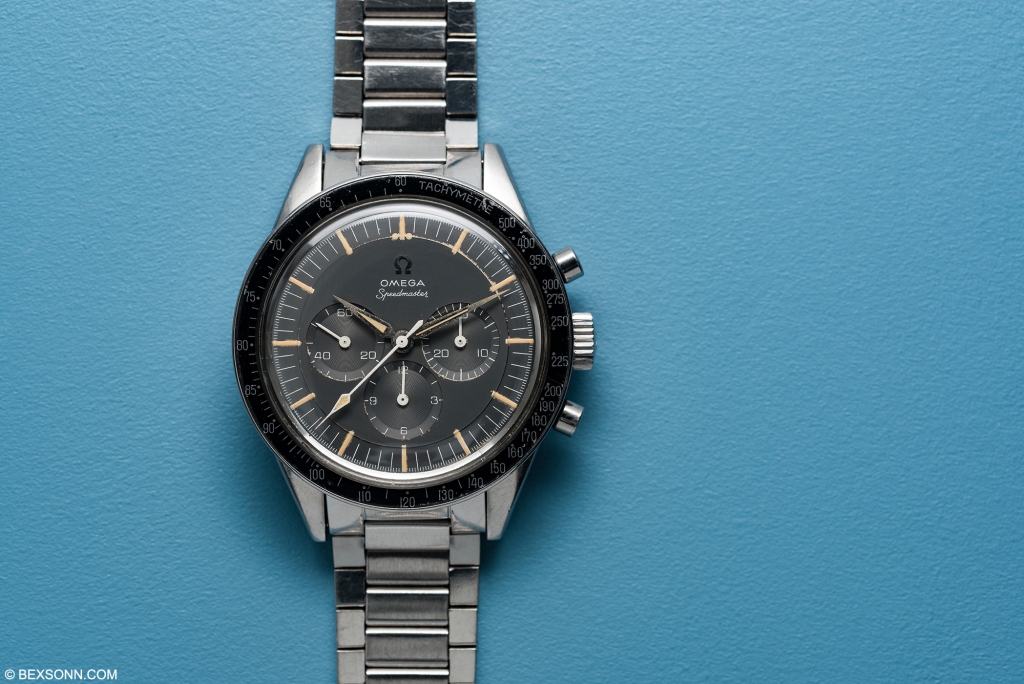 Lot 178: We just love Speedmaster’s and admittedly featured quite a few here in the past. That said, we’ve also looked at Speedmasters from Watches of Knightsbridge auctions before but this one is just a bit special. I’ve seen my fair share of discoloured brown dial Speedmasters and even one before with a blue sunburst dial. Seeing a sunburst grey dial is a first for me and it would appear these pieces are extremely rare – though its true origins are unclear. According to my current Omega Speedmaster bible (Moonwatch Only) this example is from a series of different coloured dials made by Omega and is classed as “dial projects” in special colours though the status of these rare dials is not yet fully known.
Lot 178: We just love Speedmaster’s and admittedly featured quite a few here in the past. That said, we’ve also looked at Speedmasters from Watches of Knightsbridge auctions before but this one is just a bit special. I’ve seen my fair share of discoloured brown dial Speedmasters and even one before with a blue sunburst dial. Seeing a sunburst grey dial is a first for me and it would appear these pieces are extremely rare – though its true origins are unclear. According to my current Omega Speedmaster bible (Moonwatch Only) this example is from a series of different coloured dials made by Omega and is classed as “dial projects” in special colours though the status of these rare dials is not yet fully known.
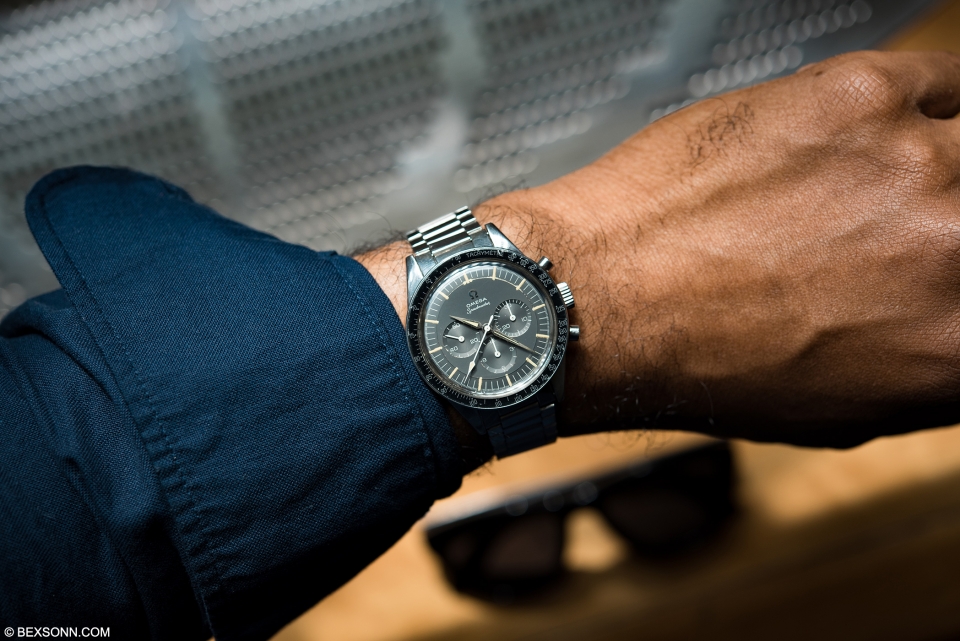 This 1963 Speedmaster ref 105.002-62 features as mentioned a grey sunburst dial with applied luminous markers, applied Omega logo, triple sub dial registers recording hour, minutes and continuous seconds, with central chronograph seconds and a step dial. Inside is the infamous calibre 321 and it comes on an expandable Omega 7912 flat link bracelet, with period correct 6 end links, which is numbered and dated 3/63 (third quarter of 1963). It also features a period correct “DON” (dot over ninety) bezel, which also bears signs of ageing. Due to the scarcity of these pieces, this extremely rare Omega Speedmaster is up for auction at an estimated price of £25,000 – £35,000.
This 1963 Speedmaster ref 105.002-62 features as mentioned a grey sunburst dial with applied luminous markers, applied Omega logo, triple sub dial registers recording hour, minutes and continuous seconds, with central chronograph seconds and a step dial. Inside is the infamous calibre 321 and it comes on an expandable Omega 7912 flat link bracelet, with period correct 6 end links, which is numbered and dated 3/63 (third quarter of 1963). It also features a period correct “DON” (dot over ninety) bezel, which also bears signs of ageing. Due to the scarcity of these pieces, this extremely rare Omega Speedmaster is up for auction at an estimated price of £25,000 – £35,000.
ROLEX MILGAUSS 1019
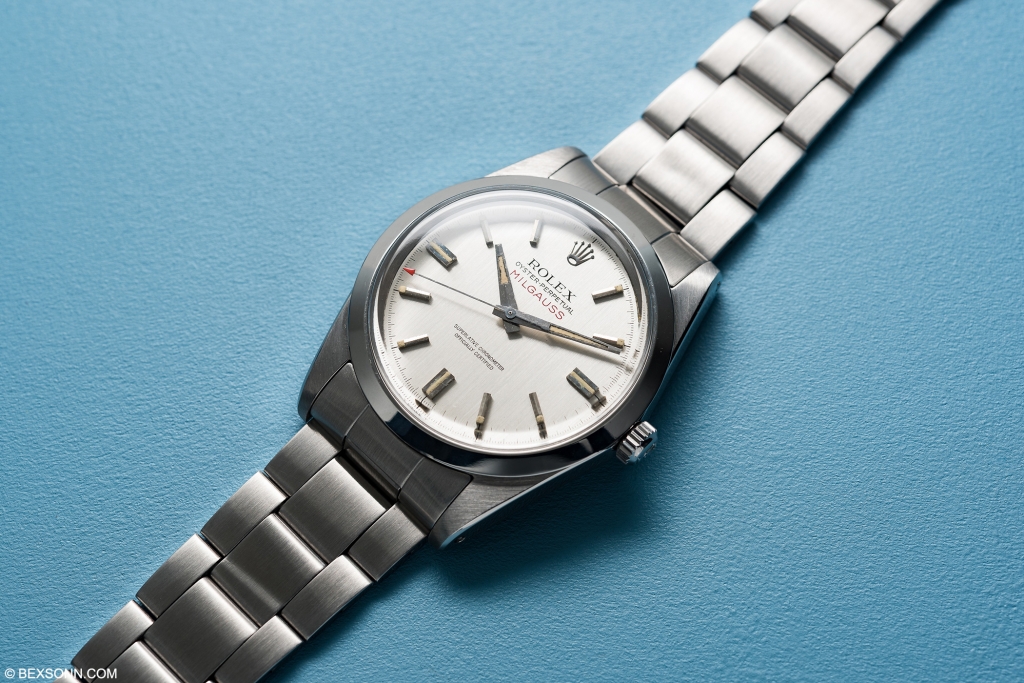 Lot 251: The Rolex Milgauss is much like other amagnetic timepieces introduced around the 1950s, i.e. the Railmaster and Ingenieur but of course made in the Rolex way. Rolex, approached by CERN were asked to produce a wristwatch that could withstand up to 1000 gauss – hence mille gauss. The original Milgauss was introduced in 1958; the reference 6541 and this sported the iconic red-tipped lightning bolt second’s hand and honeycomb dial. This 1019 is the predecessor to the 6541 and spanned a production period from the 1960s to the late 80s at which point it was discontinued. While the Milgauss has never really been a popular seller, collectors are drawn by the allure of such pieces and this example exhibits enticing warm patina.
Lot 251: The Rolex Milgauss is much like other amagnetic timepieces introduced around the 1950s, i.e. the Railmaster and Ingenieur but of course made in the Rolex way. Rolex, approached by CERN were asked to produce a wristwatch that could withstand up to 1000 gauss – hence mille gauss. The original Milgauss was introduced in 1958; the reference 6541 and this sported the iconic red-tipped lightning bolt second’s hand and honeycomb dial. This 1019 is the predecessor to the 6541 and spanned a production period from the 1960s to the late 80s at which point it was discontinued. While the Milgauss has never really been a popular seller, collectors are drawn by the allure of such pieces and this example exhibits enticing warm patina.
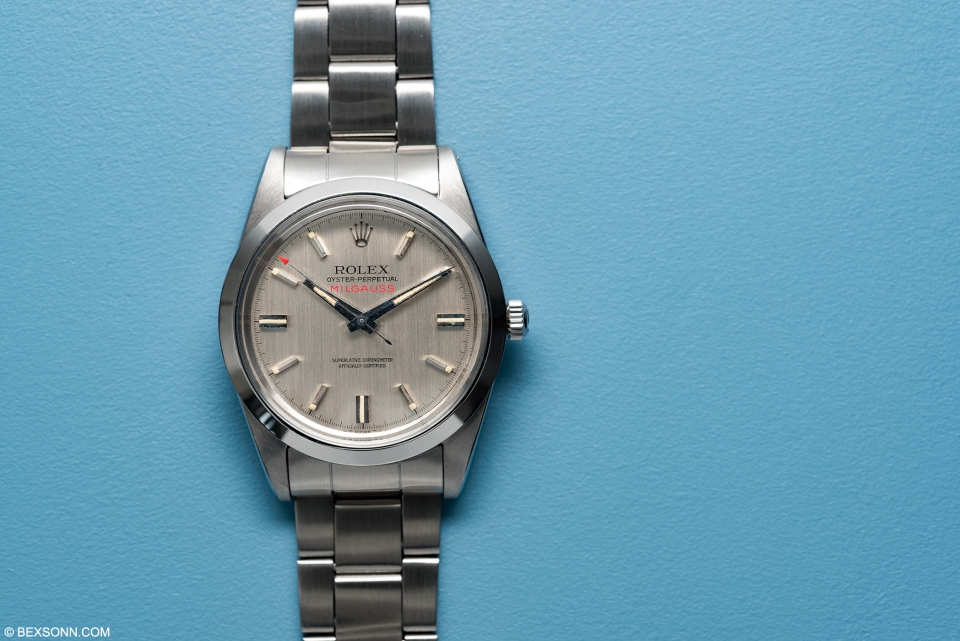 This 1968 Milgauss reference 1019 features a silver “rail” dial with square lume and luminous inlaid silver batons at 3, 6 and 9 o’clock. As well as sword hands and the all-important red-tipped arrow seconds hand. Inside is the Rolex calibre 1580, which is protected by the anti-magnetic Faraday cage. The 38mm case on this example is in excellent condition, considering its age and is up for auction at an estimate of £13,000 – £16,000.
This 1968 Milgauss reference 1019 features a silver “rail” dial with square lume and luminous inlaid silver batons at 3, 6 and 9 o’clock. As well as sword hands and the all-important red-tipped arrow seconds hand. Inside is the Rolex calibre 1580, which is protected by the anti-magnetic Faraday cage. The 38mm case on this example is in excellent condition, considering its age and is up for auction at an estimate of £13,000 – £16,000.
ROLEX EXPLORER II 1655 TIFFANY & CO.
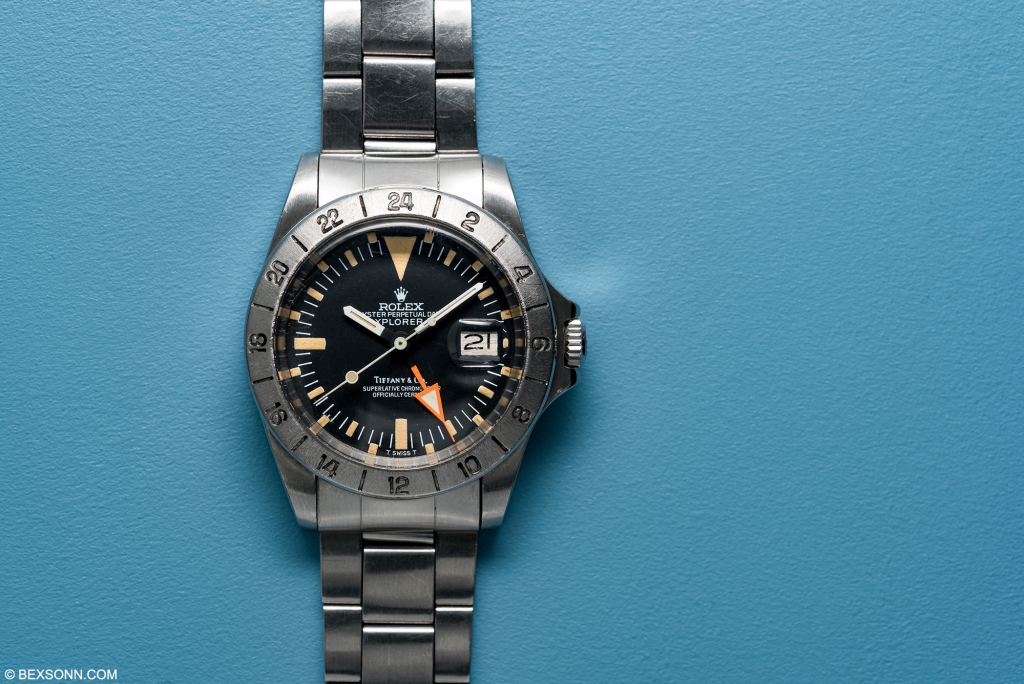 Lot 252: The Rolex Explorer II is a rather peculiar watch to most but Rolex don’t make wristwatches which have no use. That said, while it may have very little use to most of us it is still one iconic piece. Introduced in 1971, the Explorer II was launched as Explorer with an additional function – hence the II. Aimed at speleologist (cave explorers), who worked in the dark for the majority of the time, it is said that they could easily lose track of time and become a little disoreinted; which is the reason Rolex introduced this piece. So as you’ll notice what may actually look like a nice large orange hand for tracking a second time zone, is in fact a day/night indicator, with a bezel marked with a 24-hour scale, despite the fact the 1655 made use of the same movement as the GMT-Master 1675.
Lot 252: The Rolex Explorer II is a rather peculiar watch to most but Rolex don’t make wristwatches which have no use. That said, while it may have very little use to most of us it is still one iconic piece. Introduced in 1971, the Explorer II was launched as Explorer with an additional function – hence the II. Aimed at speleologist (cave explorers), who worked in the dark for the majority of the time, it is said that they could easily lose track of time and become a little disoreinted; which is the reason Rolex introduced this piece. So as you’ll notice what may actually look like a nice large orange hand for tracking a second time zone, is in fact a day/night indicator, with a bezel marked with a 24-hour scale, despite the fact the 1655 made use of the same movement as the GMT-Master 1675.
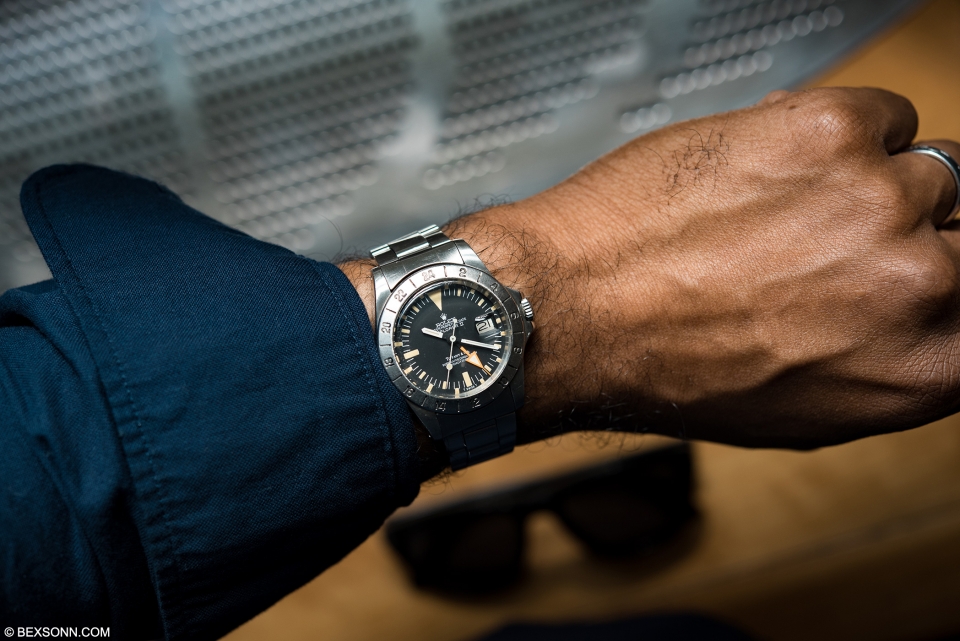 While the Explorer II doesn’t quite have the same allure as a Submariner, Daytona or GMT, there is a special appreciation for these pieces among collectors. The 1655 was never a popular watch while it was produced but maybe this was down to marketing, who knows but you don’t see them as often as the pieces already mentioned. Its unpopularity is perhaps what makes it what it is today. And adding to the appeal of this example is the fact it sports a MK2 dial signed by none other than Tiffany & Co., which not only makes it more collectible but also rarer. This Rolex Explorer II is up for auction at an estimate of £18,000 – £22,000.
While the Explorer II doesn’t quite have the same allure as a Submariner, Daytona or GMT, there is a special appreciation for these pieces among collectors. The 1655 was never a popular watch while it was produced but maybe this was down to marketing, who knows but you don’t see them as often as the pieces already mentioned. Its unpopularity is perhaps what makes it what it is today. And adding to the appeal of this example is the fact it sports a MK2 dial signed by none other than Tiffany & Co., which not only makes it more collectible but also rarer. This Rolex Explorer II is up for auction at an estimate of £18,000 – £22,000.
ROLEX DATEJUST 1601
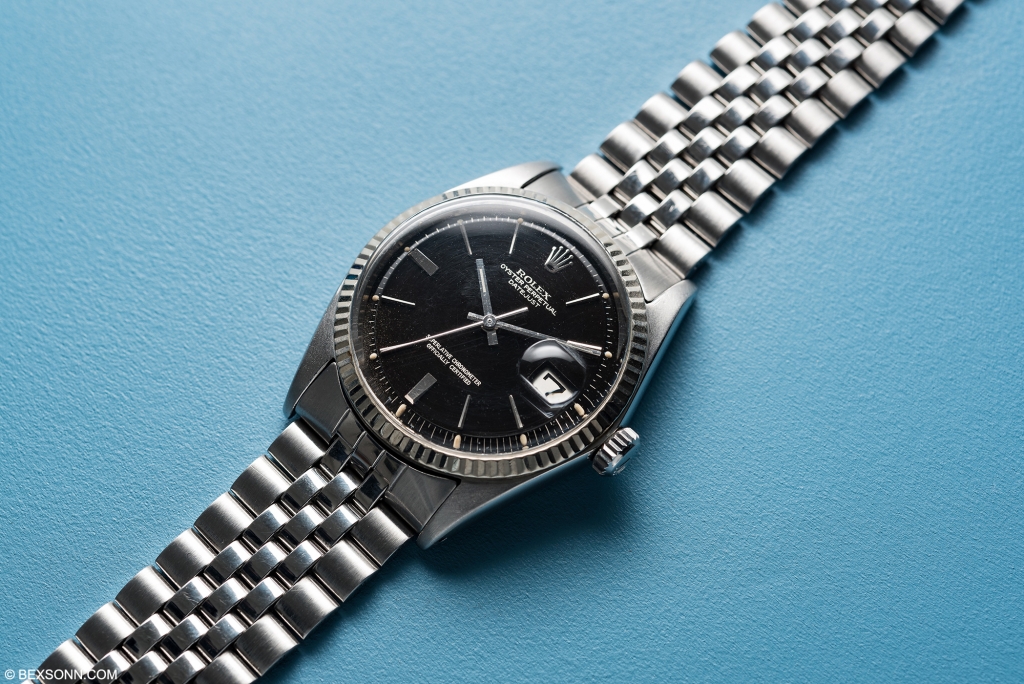 Lot 270: Rolex introduced the humble Datejust to the market back in 1945 – the world’s first self-winding watch to display the date complication via an aperture. Over time, Rolex experimented with different dials to further enhance the Datejust’s timeless appeal. This present lot was a personal favourite pick of mine but too many it just looks like a simple Datejust that’s probably because it is. But look closer and you’ll notice the bags of character it has.
Lot 270: Rolex introduced the humble Datejust to the market back in 1945 – the world’s first self-winding watch to display the date complication via an aperture. Over time, Rolex experimented with different dials to further enhance the Datejust’s timeless appeal. This present lot was a personal favourite pick of mine but too many it just looks like a simple Datejust that’s probably because it is. But look closer and you’ll notice the bags of character it has.
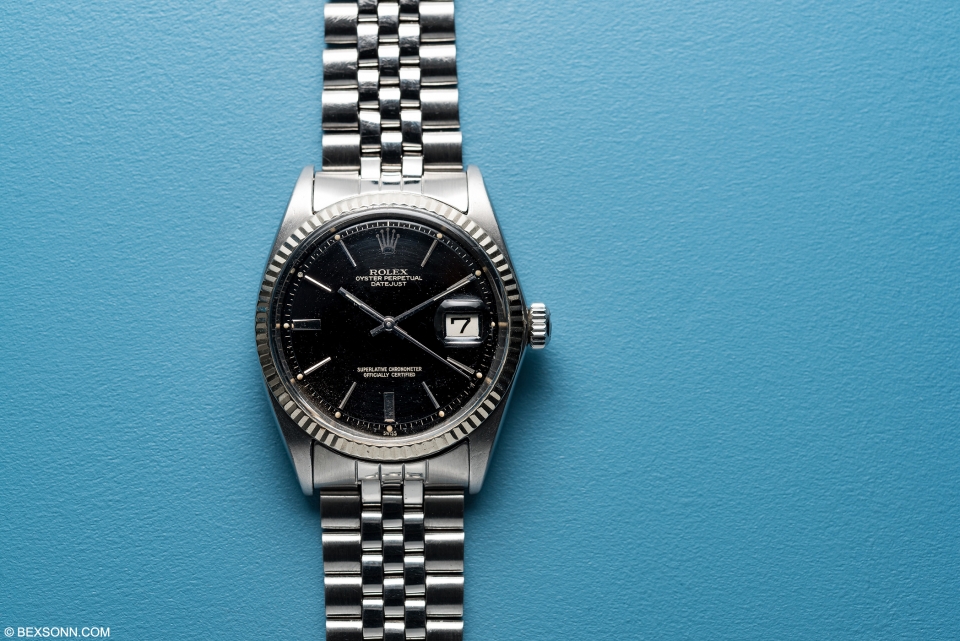 This 1965 Datejust is fitted with a black gilt gloss dial, which has just started to discolour to an extremely dark chocolate tone, though this is not perhaps evident in the images, trust me when I say it is. Moreover, it also exhibits what is known by aficionados alike as “door stop” markers at 6 and 9 o’clock. The lume plots are nice and even, displaying a warm creamy tone. The case is as good as you could expect a 50-year-old plus watch to be and is fitted with a white-gold fluted bezel. Rolex has a way of creating timeless designs and the Datejust is up there with some of the best designs of the 20th century. It’s elegant yet still display masculine qualities and I think as a collector it is one watch that you should own at least once in your watch collecting life time. The beautiful Datejust is up for auction at an estimate of £2,500 – £3,500.
This 1965 Datejust is fitted with a black gilt gloss dial, which has just started to discolour to an extremely dark chocolate tone, though this is not perhaps evident in the images, trust me when I say it is. Moreover, it also exhibits what is known by aficionados alike as “door stop” markers at 6 and 9 o’clock. The lume plots are nice and even, displaying a warm creamy tone. The case is as good as you could expect a 50-year-old plus watch to be and is fitted with a white-gold fluted bezel. Rolex has a way of creating timeless designs and the Datejust is up there with some of the best designs of the 20th century. It’s elegant yet still display masculine qualities and I think as a collector it is one watch that you should own at least once in your watch collecting life time. The beautiful Datejust is up for auction at an estimate of £2,500 – £3,500.
The Watches of Knightsbridge auction will take place on the 16th September 2017, make sure you visit their new website for this month’s full catalogue.
